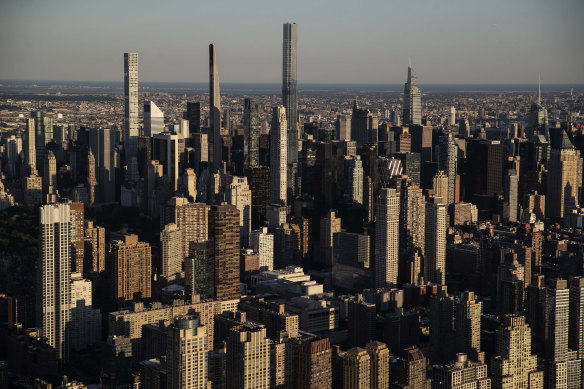Opinion
Could working from home cause the next financial crisis?
William Bennett
Money contributorNew York: Inflation is conquered, unemployment is at record lows, stock markets are at all-time highs, and I managed to get double tickets to both Barbie and Oppenheimer last weekend. Seems like things are back to “normal” post-pandemic.
Yet there is one lingering pandemic hangover: working from home, and just like the dichotomous “Barbenheimer” opening weekend, WFH has juxtaposed the “Barbieland” residential real estate market to the nuclear winter that is engulfing commercial real estate (CRE).

The pandemic holdover of working from home has juxtaposed the “Barbieland” residential real estate market to the Oppenheimer-esque nuclear winter engulfing commercial real estate.Credit: AP
While a soft-landing looks to have been charted for the broader economy, for CRE “the wings of the plane are on fire; the plane is coming down. It’s just a matter of how hard it’s going to hit. It is apocalyptical,” said Fred Cordova at US-based CRE brokerage firm Corion Enterprises.
Working from home will see demand for office space across the largest global cities fall by 13 per cent in 2030 compared to pre-pandemic levels, wiping out $US800 billion ($1.1 trillion) of value, according to a recent report by McKinsey.
In Australia, office vacancy rates hit 12-month highs in June, at 14.4 per cent in Sydney and 16.2 per cent in Melbourne, according to JLL Research. Here in New York, the vacancy rate in Lower Manhattan’s Financial District recently reached 25.6 per cent, and 19.9 per cent in Midtown.
To put this into perspective, roughly three Central Parks could fit into New York’s vacant office space of over 9 million square metres. While the average across the United States sits at approximately 20 per cent, San Francisco, which pioneered working from home is suffering the worst, with vacancy rates nearing 32 per cent.
You’ve got a double whammy. You’ve got occupancy down...there’s less income coming in, and the cost of capital has gone up exponentially.
John Fish, former chair of the Boston Federal Reserve
New York mayor Eric Adams has pleaded with employers to enforce return to office requirements as CRE taxes contribute to 20 per cent of the city’s tax revenue – falling during a time in which City Hall faces blowout budget deficits.
Higher vacancy rates have caused rents to plummet, and coupled with higher borrowing costs office values are tanking, falling 27 per cent since March 2022. Office and retail property valuations could fall as much as 40 per cent from peak to trough and increase the risk of defaults, says Morgan Stanley.
In comparison, residential house prices across the US continue to grind higher, up 2.7 per cent over the same period.
A short stroll from my apartment on Fifth Avenue, a 20-storey office building recently sold for $150 million, an almost 40 per cent discount from its 2020 valuation.
“In New York, buildings are selling for less than the value of the land they sit on,” Will Silverman of investment bank Eastdil Secured told the Financial Times.
“You’ve got a double whammy. You’ve got occupancy down, so the value is down, there’s less income coming in, and the cost of capital has gone up exponentially,” says John Fish, former chair of the Boston Federal Reserve.
And it won’t be until 2040 that office values are predicted to recover to pre-pandemic levels, prompting some large investors such as Brookfield and Blackstone to just walk away from multimillion-dollar properties.
In Australia, there are early signs of cracks appearing, with something akin to a bank run beginning in commercial REITs (real estate investment trusts).
ASX-listed Charter Hall Group recently limited investor withdrawals from some unlisted office funds, while Dexus, another REIT, made a loss last month selling a premium downtown Sydney office block for a 17 per cent discount on a valuation made six months earlier.
A property apocalypse?
Back in the US, $189 billion of debt on office buildings is estimated to mature this year with another $117 billion due in 2024, according to the Mortgage Bankers Association. Over the next three years, $1.5 trillion of commercial real estate loans are due to mature.
At the end of June, $24.8 billion of US office buildings were in distress, with the value of offices that were financially troubled or already repossessed rocketing 36 per cent in just three months, according to data from MSCI Real Assets.
The big question is, who is going to lend the money needed to refinance these loans?

It won’t be until 2040 that office values are predicted to recover to pre-pandemic levels.Credit: Bloomberg
“There’s no easy answer right now, and our view is that it gets harder throughout the next six months,” says Lauren Basmadjian of Carlyle Group. Last week the major banks told investors they increased allowances for credit losses on CRE loans.
”We are reserving for the weakness that we expect to play out in the market over time,” Wells Fargo CEO Charlie Scharf told investors (offices represent approximately 22 per cent of Wells Fargo’s commercial property loans).
According to the Federal Reserve’s stress test, if CRE prices fall by 40 per cent, the 23 largest banks stand to lose $64.9 billion. But it’s the small and regional banks that have the highest exposure, according to Reuters, with 30 to 40 per cent of their book in real estate.
Sensing a crisis, the bargain hunters have begun circling. “You can see a pullback in lending, you can see vacancies in office, troubles in retail for years and years […] there may be opportunities to buy,” said Seth Klarman, founder of the $30 billion Baupost hedge fund, which made billions buying distressed assets during the GFC.
Turning offices into apartments
With cities like New York and Sydney simultaneously facing scarce housing and underutilised office space, office-to-residential conversions seem the obvious solution. But it’s easier said than done.
Steve Paynter, a principal at the design firm Gensler, has been evaluating hundreds of office buildings across North America and recently told Fortune he estimates as many as 30 per cent could be fit for residential conversion.
Converting open-plan office spaces into apartments with bathrooms and kitchens is no easy feat. Conversion is estimated to cost as much as $400-$500 per square foot, often more expensive than building a new development.
The largest office-to-residential conversion in the U.S. is currently taking place in Lower Manhattan, but at 1.1 million square feet, it could cost up to $550 million to convert a property that cost $250 million to purchase.
“It’s one asset class that just has to get redone, and redone meaning demolished,” said Kyle Bass, of hedge fund Hayman Capital Management.
Back to work
With conversions unlikely, a swing back towards the majority in office could avert a crisis. But employees are clinging to their sweatpants and sleep-ins for dear life despite growing pressure from bosses and mounting data pointing to WFH being less productive and eroding corporate culture.
Roughly half of those working in finance say they would quit if asked to spend more time in the office, according to a recent Markets Live Pulse survey.
And who would blame them? With benefits like no commuting, taking Fridays off (after maybe one morning Zoom meeting) and more time for golf (midday attendance has skyrocketed since the shift to WFH).
Amazon recently announced they will require some corporate employees to relocate as part of a return to work mandate, joining a growing list of companies threatening consequences if workers don’t return to the office.
Others have resorted to AI fearmongering.
“The latest wave of AI will likely bring people back to the office … the best way a human can differentiate themselves from a robot is in person,” says Kevin Ellis, chairman of PwC in London.
Perhaps there is a compromise in a four-day working week, which has proven a success in Britain according to both bosses and workers, and in doing so avert an Oppenheimer-style ending for the commercial real estate sector.
For expert tips on how to save, invest and make the most of your money, delivered to your inbox every Sunday, sign up for our Real Money newsletter here.